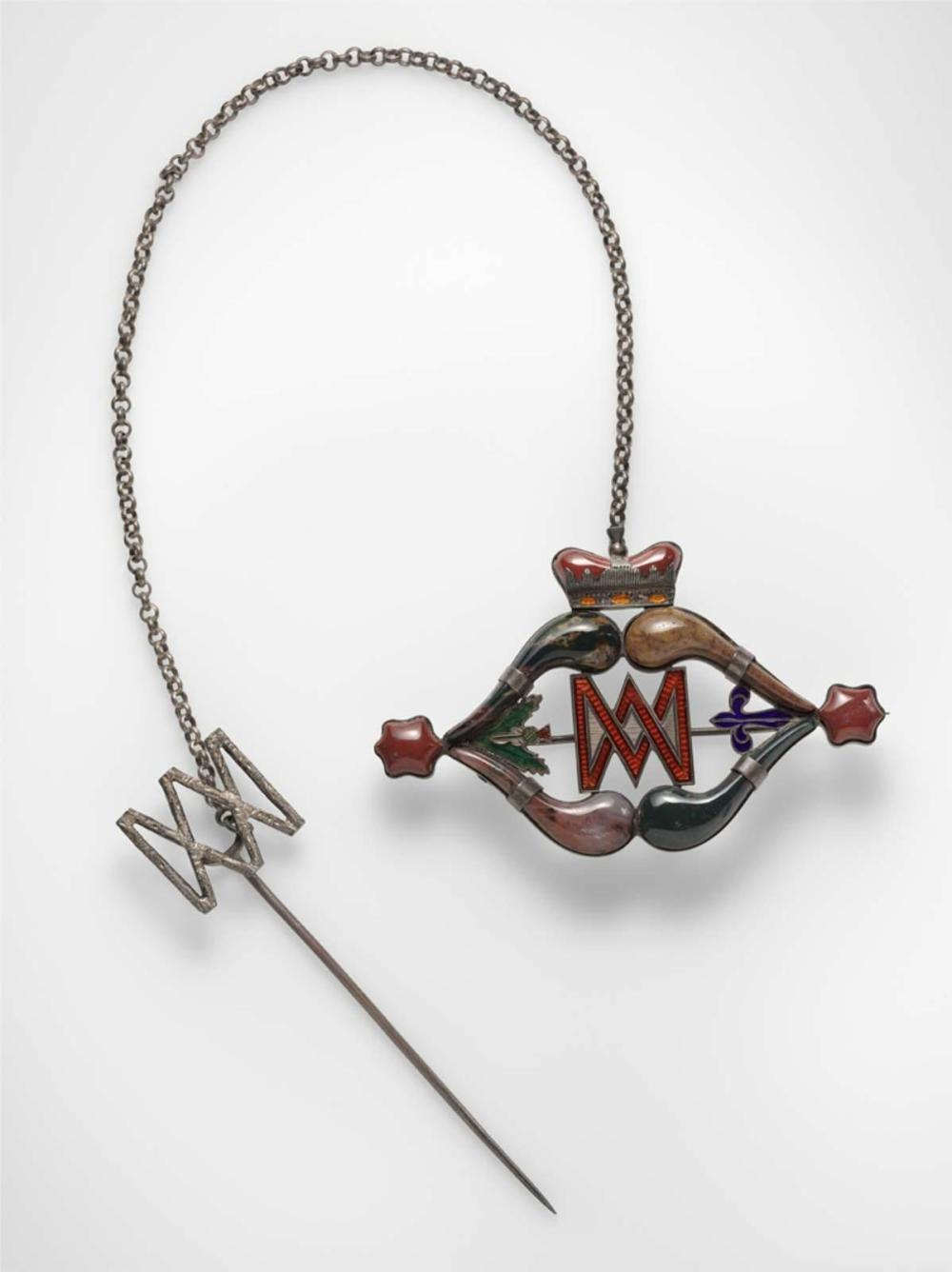Advanced Search 

Queen Mary brooch
Scottish
1850–1900
Object Place: Possibly Edinburgh, Scotland; Place of Manufacture: Birmingham, England
Medium/Technique
Silver, agate, and enamel
Dimensions
38 x 7.8 x 1.4 cm (14 15/16 x 3 1/16 x 9/16 in.)
Credit Line
Gift of Miss Emily M. Babcock
Accession Number51.1967
NOT ON VIEW
ClassificationsJewelry / Adornment – Brooches
DescriptionThe art of jewelry-making flourished in Scotland during the nineteenth century. Some of the ornaments created reflected an interest in the historical past and were based on early Celtic designs while others were influenced by the Romantic Movement and a growing sense of national identity. Many of the latter were brooches inspired by the "plaid" brooches used in traditional Highland dress to secure the plaid tartan.
In England, an awareness of Scottish lore and jewelry was awakened by the writings of Sir Walter Scott and Queen Victoria and Prince Albert's passion for the Scotland. The couple first visited there in 1842 and later purchased Balmoral Castle in Aberdeenshire as a summer retreat. The couple also developed a fondness for Scottish costume and adornment, especially those ornaments made with local stones, called cairngorms, which are a variety of yellow-brown quartz named after the Cairngorms mountain range in the eastern Highlands.
It was not long before Scottish "pebble" jewelry became a fashion fad in England. The demand for these novelties was so great that jewelers in Birmingham and elsewhere began manufacturing a variety of forms, some only vaguely based on Scottish designs. Although the stones were occasionally set in gold, most ornaments were made of silver. When supplies of Scottish stones were nearly depleted, English metalsmiths obtained agates from Idar Oberstein, Germany, a source of cut stones since the fourteenth century.
This ornament is a form of the Luckenbooth brooch-a heart-shaped pin surmounted by a crown that was popular in the Lowlands during the 18th & 19th centuries. Many were love-tokens or betrothal gifts although there is some evidence that its use also served as a protection against witches. In 18th century Scotland, they were made by silversmiths in country districts, but during the 19th century their manufacture was taken over by craftsmen in the cities who created more elaborate versions that were sometimes set with stones. The name "Luckenbooth" comes from the fact that many were sold in the luckenbooths (street stalls) around St. Gile's church in Edinburgh. In this example, there are two hearts laid on their sides to look like confronting scrolls. Both the enameling and agate type suggest that it was made in England, rather than Scotland. On reverse is the engraved inscription, MRS. E.B. ALWARD/1865/1876.
In England, an awareness of Scottish lore and jewelry was awakened by the writings of Sir Walter Scott and Queen Victoria and Prince Albert's passion for the Scotland. The couple first visited there in 1842 and later purchased Balmoral Castle in Aberdeenshire as a summer retreat. The couple also developed a fondness for Scottish costume and adornment, especially those ornaments made with local stones, called cairngorms, which are a variety of yellow-brown quartz named after the Cairngorms mountain range in the eastern Highlands.
It was not long before Scottish "pebble" jewelry became a fashion fad in England. The demand for these novelties was so great that jewelers in Birmingham and elsewhere began manufacturing a variety of forms, some only vaguely based on Scottish designs. Although the stones were occasionally set in gold, most ornaments were made of silver. When supplies of Scottish stones were nearly depleted, English metalsmiths obtained agates from Idar Oberstein, Germany, a source of cut stones since the fourteenth century.
This ornament is a form of the Luckenbooth brooch-a heart-shaped pin surmounted by a crown that was popular in the Lowlands during the 18th & 19th centuries. Many were love-tokens or betrothal gifts although there is some evidence that its use also served as a protection against witches. In 18th century Scotland, they were made by silversmiths in country districts, but during the 19th century their manufacture was taken over by craftsmen in the cities who created more elaborate versions that were sometimes set with stones. The name "Luckenbooth" comes from the fact that many were sold in the luckenbooths (street stalls) around St. Gile's church in Edinburgh. In this example, there are two hearts laid on their sides to look like confronting scrolls. Both the enameling and agate type suggest that it was made in England, rather than Scotland. On reverse is the engraved inscription, MRS. E.B. ALWARD/1865/1876.
